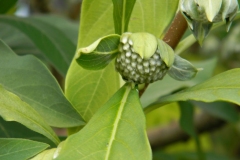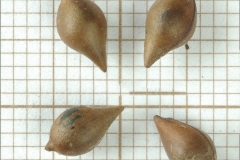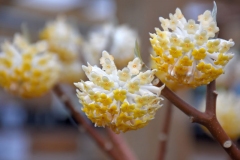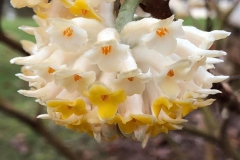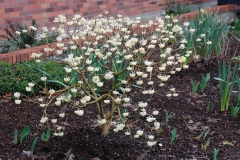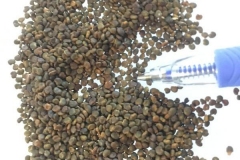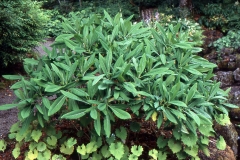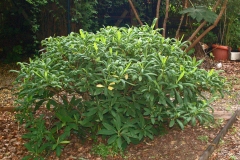| Paperbush Quick Facts | |
|---|---|
| Name: | Paperbush |
| Scientific Name: | Edgeworthia chrysantha |
| Origin | Chinese provinces of Fujian, Guangdong, Guangxi, Guizhou, Henan, Hunan, Jiangxi, Yunnan, and Zhejiang |
| Shapes | Ellipsoidal stone fruit with a length of about 8 mm and a diameter of about 3.5 mm |
| Name | Paperbush |
|---|---|
| Scientific Name | Edgeworthia chrysantha |
| Native | Chinese provinces of Fujian, Guangdong, Guangxi, Guizhou, Henan, Hunan, Jiangxi, Yunnan, and Zhejiang and was probably introduced to Korea and Japan where it has been cultivated since the late 16th century |
| Common Names | Chinese provinces of Fujian, Guangdong, Guangxi, Guizhou, Henan, Hunan, Jiangxi, Yunnan, and Zhejiang and was probably introduced to Korea and Japan where it has been cultivated since the late 16th century |
| Name in Other Languages | Chinese: Jie xiang (结香) Dutch: Papierstruik English: Giant leaf paper plant, Oriental paperbush, Paperbush, Indian paper tree, mitsumata French: Edgeworthia à papier, Daphné à papier Japanese: Mitsumata (ミツマタ), Mitsumata (みつまた) Korean: Hwang seo hyang na mu (황서향나무), Mae deup sam ji na mu (매듭삼지나무), Sam a na mu (삼아나무), Sam ji dak na mu (삼지닥나무 ) Persian: میتسوماتا Russian: Edgevortiia (Эдгевортия), Edzhvortiia bumazhnaia (Эджвортия бумажная), Bumazhnoe derevo (Бумажное дерево) Swedish: Mitsumatabuske |
| Plant Growth Habit | Small to medium-sized, beautiful, broadleaf, winter-flowering, scented, deciduous shrub |
| Growing Climates | Forests, shrubby slopes, dry sandy soil; from coastal areas to stream sides in mountain valleys |
| Soil | Thrives in moist, acidic soil that is well-drained and rich in organic matter |
| Plant Size | 3- to 4-feet tall and as much as 4- to 6-feet across |
| Leaf | Leaves single, alternate, lanceolate to narrow ovate, 8-13 cm long and 2-5 cm wide, entire, dull green, gray-green below with silky hairs when young |
| Flowering season | February to April |
| Flower | The stalked, fragrant, hermaphrodite flowers are radial symmetry and four-fold. The four sepals are fused Roehrig. The calyx tube, yellow on the inside and thickly white silky haired on the outside, has a length of 13 to 20 mm and a diameter of 4 to 5 mm |
| Fruit Shape & Size | Ellipsoidal stone fruit with a length of about 8 mm and a diameter of about 3.5 mm |
| Season | May to August |
Plant Description
Paperbush is a small to medium-sized, beautiful, broadleaf, winter-flowering, scented, deciduous shrub that normally grows about 3- to 4-feet tall and as much as 4- to 6-feet across. The plant is found growing in forests, shrubby slopes and dry sandy soil from coastal areas to stream sides in mountain valleys. The plant thrives in moist, acidic soil that is well-drained and rich in organic matter. Their long bast fibers are used to make Japanese paper.
Leaves
The leaves fall off before flowering. The alternate arranged at the ends of the branches leaves are stalked short. The simple leaf blade is elongated, lanceolate or obscure lanceolate with a length of 8 to 20 cm and a width of 2.5 to 5.5 cm with a gradually narrowing blade base and a pointed upper end. Both leaf surfaces are whitish silky hairy, denser on the underside. The 10 to 13 pairs of lateral nerves are thin and curved and hairy with downy hair.
Inflorescence and flower
The flowering time at the natural sites in China extends from late winter to early spring. The 1 to 2 cm long inflorescence stem is grayish-white rough haired. The terminal and lateral, capid inflorescences contain 30 to 50 flowers. The approximately ten bracts are finely hairy.
The stalked, fragrant, hermaphrodite flowers are radial symmetry and four-fold. The four sepals are fused Roehrig. The calyx tube, yellow on the inside and thickly white silky haired on the outside, has a length of 13 to 20 mm and a diameter of 4 to 5 mm. The four calyx lobes are ovate-lanceolate with a length of about 3.5 mm and a width of about 3 mm. There are no petals, not even rudimentary. There are two circles with four stamens each. The anthers are almost egg-shaped with a length of about 2 mm. The flat, cup-shaped disc has irregular edges. The above constant, unilocular ovary is mm and a length of about 4 and a width of about 2 mm oval with silky hairy upper end. The bald, about 2 mm long stylus ends in a spherical scar with a diameter of about 3 mm. Flowering normally takes place in between February to April.
Fruit
The base of the fruit is enclosed in the durable cup. The ellipsoidal stone fruit with a length of about 8 mm and a diameter of about 3.5 mm has a downy hairy upper end. The fruits ripen between spring and summer.
Traditional uses and benefits of Paperbush
- The sliced root is used as a remedy for eye diseases
- The bark and roots have anti-inflammatory and analgesic properties.
- The flower buds are used to treat eye diseases.
Other Facts
- The bark of Edgeworthia chrysantha is used for making high-quality, hand-made paper, including ornamental Japanese wallpaper and calligraphy paper.
- In the past it was even used to make high-quality banknotes.
- The bark fibers are used.
- The stems are harvested in spring or early summer, the leaves are removed and the stems steamed until the fibers can be stripped.
- The outer bark is removed from the inner by peeling or scraping.
- The paper is off white in color.
- The stems are extremely supple and can be tied in knots.
References:
https://www.itis.gov/servlet/SingleRpt/SingleRpt?search_topic=TSN&search_value=512730#null
https://pfaf.org/user/Plant.aspx?LatinName=Edgeworthia+chrysantha
http://www.missouribotanicalgarden.org/PlantFinder/PlantFinderDetails.aspx?taxonid=293415
https://davesgarden.com/guides/pf/go/1158/#b
https://de.zxc.wiki/wiki/Edgeworthia_chrysantha
http://www.theplantlist.org/tpl1.1/record/kew-2784524
https://gd.eppo.int/taxon/EDGPA
http://www.naturalmedicinalherbs.net/herbs/e/edgeworthia-chrysantha.php



